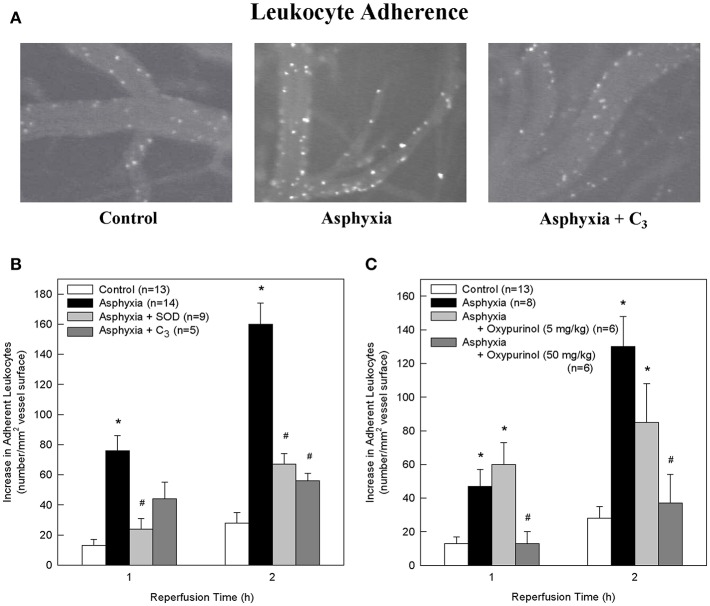Figure 1.
SOD, the SOD mimetic C3, and oxypurinol block the asphyxia-mediated increase in leukocyte adherence. (A) Representative images of rhodamine 6G-labeled adherent leukocytes in control animals, asphyxial animals, and asphyxial animals administered C3, at 2 h of reperfusion. (B) Animals induced with asphyxia and concomitant window superfusion with aCSF (n = 14) exhibited a statistically significant increase in leukocyte adherence relative to control animals (n = 13) at both 1 and 2 h of reperfusion. Animals continuously administered 1,000 U/ml SOD at a rate of 50 μl/min by window superfusion beginning 30 min prior to asphyxia (n = 9) exhibited significantly decreased leukocyte adherence relative to asphyxial animals at both 1 and 2 h of reperfusion. Animals continuously administered 300 μM C3 at a rate of 50 μl/min by window superfusion beginning 30 min prior to asphyxia (n = 5) exhibited significantly decreased leukocyte adherence relative to asphyxial animals at 2 h of reperfusion. (C) Animals induced with asphyxia without aCSF superfusion across the window (n = 8) had a statistically significant increase in leukocyte adherence relative to control animals (n = 13) at both 1 and 2 h of reperfusion. Animals administered 50 mg/kg oxypurinol 30 min prior to undergoing the asphyxia protocol (n = 6) exhibited significantly decreased leukocyte adherence relative to asphyxial animals at both 1 and 2 h of reperfusion. Animals administered 5 mg/kg oxypurinol 30 min prior to undergoing the asphyxia protocol (n = 6) exhibited no change in leukocyte adherence relative to asphyxial animals at either time point. Values shown (mean ± S.E.M.) represent increases above baseline in the number of leukocytes adherent to cerebral venules after 1 and 2 h of post-asphyxial reperfusion. *p < 0.05 vs. control; #p < 0.05 vs. asphyxia.

